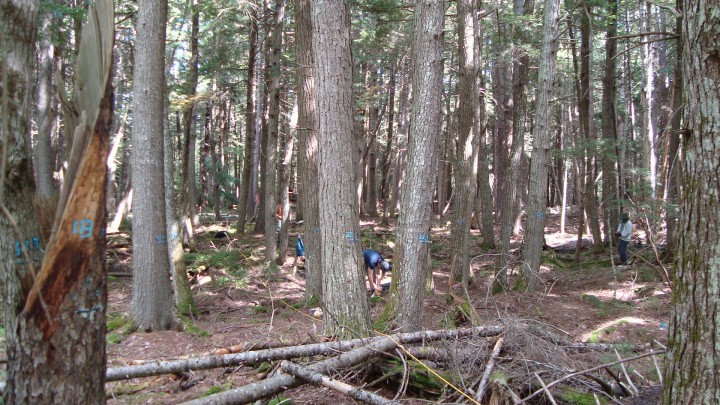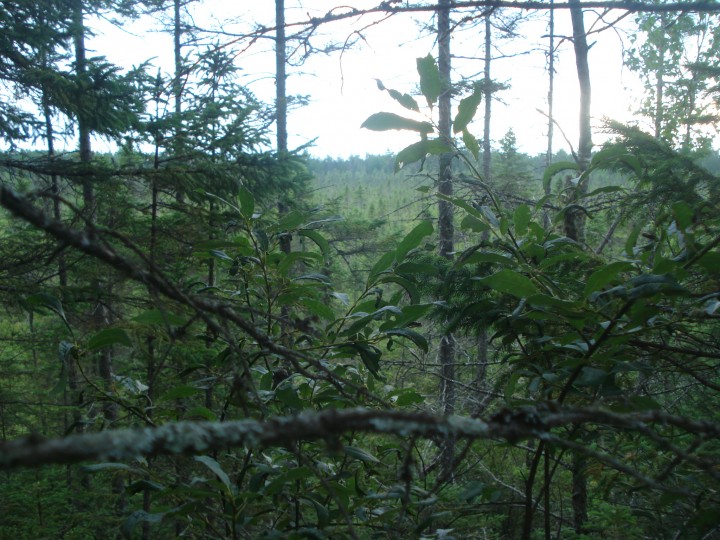Penobscot Experimental Forest, Bradley, Maine
Temperature 71°F Humidity 65% Wind 0 mph Sunny
From Dr. Jon Ranson:
This gorgeous morning we hopped in our cars and drove back to the last site, close to Lake Chemo (you can pronounce that chee-moe). Yesterday I was impressed by the high biomass and the giant Quaking Aspen trees. Today I’ve noticed that there is a lot of fallen timber in this site. We found several really big trees lying on the ground with their root pads sticking up in the air. We also saw a lot of standing dead trees, many of which had been broken off several meters above the ground. I expect this place had taken some wind not too long ago. That would explain all this deadfall.
Our remote sensing instruments don’t measure dead trees on the ground. We also can’t separate standing deadwood from live wood, either. Intact downed wood still holds carbon we know we underestimate biomass when we don’t measure it. On the other hand, if standing trees have been dead long enough, then bugs can start to eat the wood or decay begins. In that case our instruments may over estimate biomass when they measure those trees. Overall these errors are not great but its good to be aware of this.

When we’re out doing ground-truth validation, we make notations about the dead trees. If a tree is standing and dead, we note it is dead. If it is leaning, we note the angle. If it’s broken, we note the height in meters at which the break occurs. We’ll go back and compare this to the data we’ve gathered from our instruments. All of this helps us build better algorithms so we can begin to develop models to separate dead from living trees.
The significance of the amount of carbon stored in dead trees varies. In forests like the North Woods the climate is relatively warm and moist and favors rapid decomposition. So it may not be very important to figure the carbon in that wood, because it is only stored above ground for a very short time. In places like Colorado, where the weather is dry, the deadfall can stay for years so knowing that biomass is more important. In areas like Siberia, where it is very cold, decomposition of dead trees my not happen for centuries – or ever, unless there is climate warming. At some point we’d very much like to be able to quantify the dead wood with our instruments.
In the afternoon, we went out to check a bog on a site I first visited a long time ago – back in the 1980s. When I last saw it, maybe six years ago, this area was waterlogged and appeared nearly treeless. Today I drove up to the site, saw my team readying our ropes and pulling on the knee-high muck boots and I was really surprised. This bog has certainly changed. It has trees. They are tall and thin, but they are trees.
Normally trees won’t grow very well in waterlogged areas, like bogs. There is just not enough oxygen for the roots and there is little nutrient availability. Black spruce, Picea mariana, is one of the few trees that can germinate and grow in such very wet conditions. But under these conditions growth is very slow. It can take a hundred years or so to grow a tree just a few inches in diameter. So these trees that are here now were probably here at my first visit. But just so small that I didn’t even notice.
Since we were seeing trees, we had to survey the site to confirm that the trees were too small to measure. If we found trees over 10 cm, we’d have to set up our plots and subplots in the muck and go do full measurements. If they were all 10 cm or less, we’d only do an estimate based on tree size.
Ross, Jeremy and Paul were eager to put on the knee-high muck boots. First come, first served, so they went forward into the bog first, to assess if there were measurable trees. There was no sense getting everyone wet and mucky, unless we had to.

For the first little bit all that we could hear was the squishing and sucking sounds of scientists pushing through waterlogged bog. Soon we heard happy shouts. At about twenty meters in the ground rose out of the muck and it was nearly dry. They dropped a center line, assessed there were no measurable trees and completed the quantitative sampling of small trees in an hour or so.
As bogs mature and age, vegetation tends to grow centrally. As time goes by, dying vegetation will create an organic mat so the center section of the bog rises. The soil stays saturated with water so when it rains the water tends to not soak in, but to run from the center to the edges of the bog. Over time the center becomes dry while the perimeter stays quite wet. That was the case here. It was ankle deep mud on the outer edge, but the central soils were higher and drier.
The three who worked the bog came out with lots of stories about how unique and beautiful it was in there. They said the landscape was rather stark, with tall, skinny, dark and sparse tree growth. But the vegetation underfoot was unlike anything they’d seen on this trip. It was thick and soft. One of the scientists had tripped and fallen on the ground, giving him an opportunity to get a pretty personal experience. He said it reminded him of soft foam, or maybe ball pit at a kid’s play area. It felt like you might jump in, without ever hitting the bottom, basically suspended in the deep, soft, thick greenery. Bogs are unique and interesting places.
At the end of the day we all gathered at the Howland camp to compare notes and have a nice meal together. Sassan made some fabulous, mouthwatering Tandoori Chicken on the grill, and the Howland crew served up corn and veggies and all sorts of other delicious treats.
It’s been a great trip. Everyone has been energetic and willing, the weather has held wonderfully for us – thankfully those soaking hurricane rains came only on the weekends. We managed to get more measurements than we’d hoped. And we still had time to sit down for a couple of meals together. It’s been a very rewarding trip.



